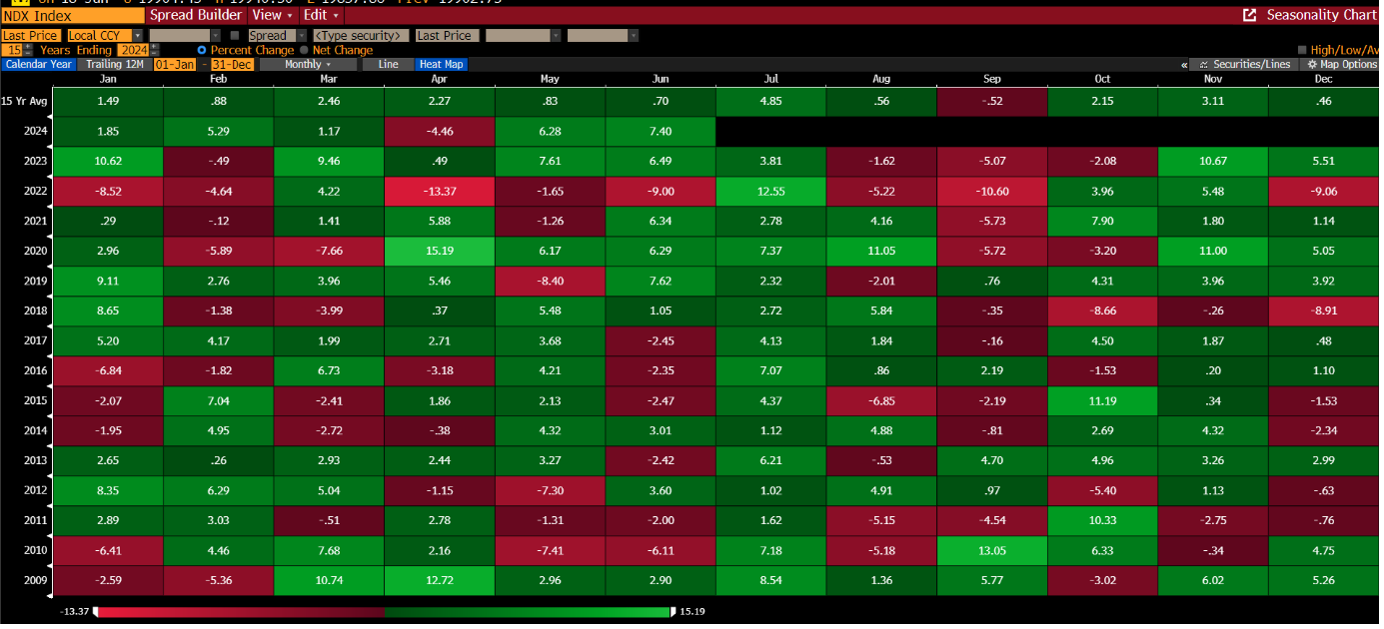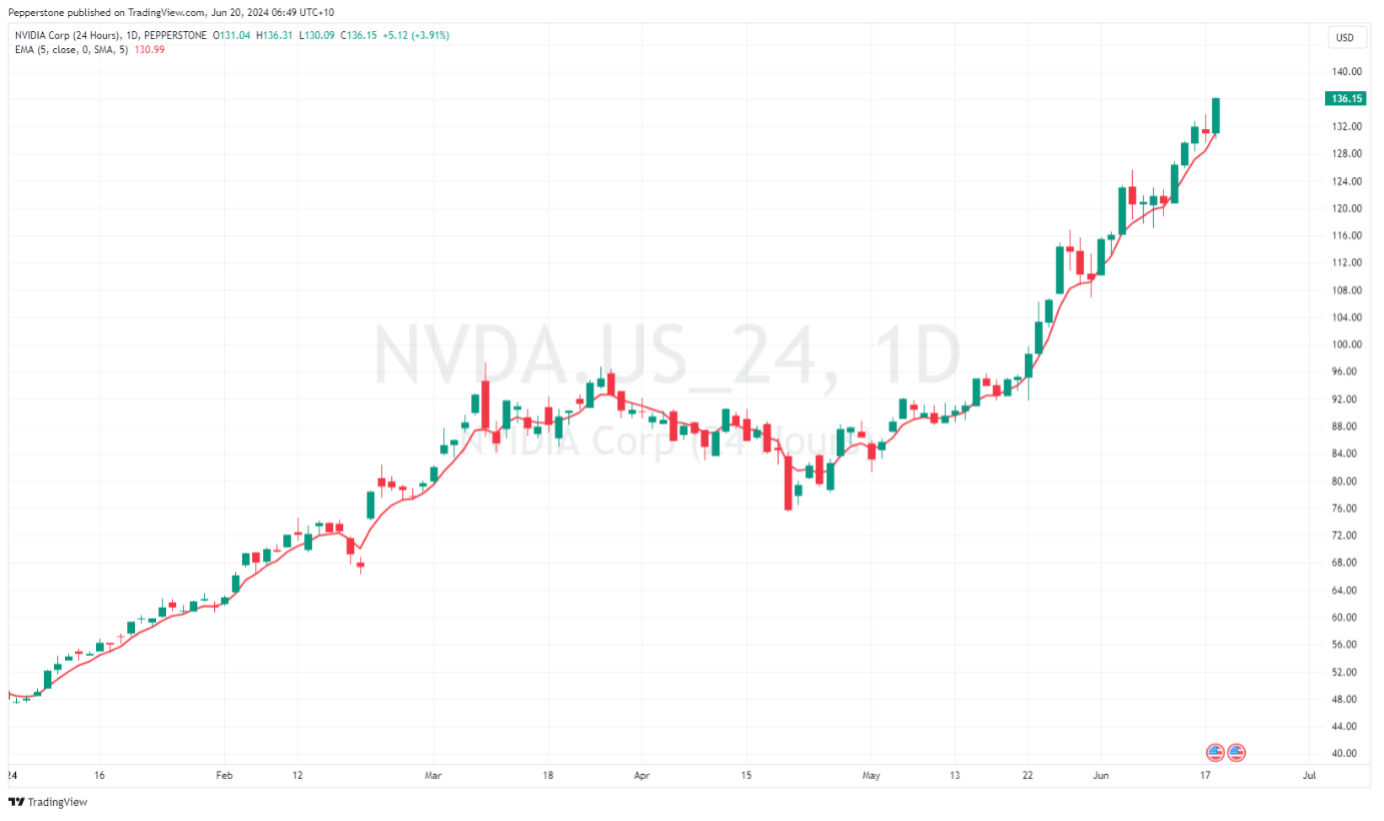Analysis
The unstoppable US equity markets – The biggest risk to the momentum juggernaut

- S&P500 YTD gains coming predominantly from six stocks
- When could we see Nvidia reverse its bull trend?
- The big risk to markets
- Why market positioning is a factor to consider
With the NAS100 eyeing 20k and the S&P500 pushing 5500, and with the knowledge that July is typically a solid month for returns in the NAS100 (the NAS100 has closed higher in July in all 15 of the last 15 years), the question of what derails this momentum move is one we hear ever more frequently from clients. Granted, all is not so rosy under the hood, where index market breadth has been poor, with participation underwhelming, suggesting the rally has been built on a shaky foundation.
(NAS100 returns per month)

As many who have tried to short these indices – at least outside of a scalp or a day trade – will attest to, bearish directional trades have been tough, as we rarely get follow-through after a 1-day down move.
Naturally, the question comes down to what rocks Nvidia, Apple, Microsoft, Meta, Alphabet and Amazon, given these six names alone have accounted for 60% of the S&P500’s 15% YTD gains. Conversely, only 30% of S&P500 constituents are outperforming the S&P500 YTD – the lowest read in two years.
It has simply been a tough trade to bet against AI in its various guises - so until we lose these behemoths then pullbacks at an index level will likely be shallow and well-supported.

Nvidia remains the most important stock in the world, having now eclipsed Microsoft as having the largest market capitalisation globally. There has been some focus that corporate insiders (within Nvidia’s upper ranks) have recently been selling down holdings, but judging by the price action, few in the investment or trading world have seen this as a signal to reduce exposures – in fact, given the daily massive level of short-dated call (option) buying relative to puts, most market players continue to chase the intraday rallies.
Maybe this dynamic changes as we head into US Q2 earnings, where Nvidia report on 23 August. Perhaps should Nvidia trade on a 55x-60x forward PE multiple (currently 50x) and where this quarterly earnings report should see a decline in gross margins into 75%, then perhaps this could be the time to rotate into other areas of the market.
The big overriding concerns that could impact
The scenario which would cause a lasting reversal in risk would be a trend towards deteriorating economic data flow, with labour markets cooling far quicker than many expect, consumption metrics pulling back rapidly and business and consumer confidence falling hard. If this was to occur, especially if inflation remains at current levels, or even rises, then all bets are off and we think about the Fed having to ease rates to stimulate the economy.
However, if the US economic data flow is really going to deteriorate increasing the prospect of a recession, which would impact corporate earnings, then it isn’t going to happen overnight and could take months to fully evolve.
We also know there is Fed insurance that supports risk sentiment, with the central bank ready to ease rates to a more neutral setting (considered to be 3.5% on the fed funds rate), should conditions warrant such action. We also know the Fed can very effectively utilize its balance sheet should it need to. Why sell equity exposure when the Fed have your back?
The French election risk rolls on and there could be further volatility going into the second-round vote on 7 July, but it is not going to spur a correction in these big US tech names. Quite the opposite in fact, where capital will likely come out of EU assets and head to the US tech plays should we see increasing concerns. The threat of France leaving the EMU is also very low, even if the right-wing RN party get a working majority.
The US Presidential election is not until 5 November, and it’s still too early to be expressing a view at this point. Again, it is early days, but the probability markets (and recent polls) currently suggest that Trump will likely be re-elected as President, with the Democrats flipping the House and the GOP getting the Senate. Granted, Trump will go hard on tariffs, but he’ll be just as hard on deregulating industries and that could be…dare I say it…. The trumping factor that sees US equity outperform.
We can go on looking at the risk factors that could spur a lasting trend reversal, but one aspect that makes me nervous is equity and volatility positioning. Now positioning alone won’t be the cause of a more prolonged drawdown in the US500, US30, US2000 or even NAS100, but it would exacerbate the pace at which any sell-off happens.
Positioning is the clear consideration
The recent Bank of America Fund Manager survey, which canvasses some 238 money managers and accounts for assets under management of $721b, highlighted that fund managers' cash levels are now at 4% - the lowest since 2021, arguing against the notion of ‘cash on the sidelines’ still ready to come into the market. Systematic trend-following funds (known as ‘CTA’s or Commodity Trading Advisors) are positioned max long of equity futures. While ‘risk parity’ funds – i.e. pension & insurance funds whose exposure to the equity market is calibrated to the level of realised volatility in the S&P500 – are also fully invested.
We see the weekly CFTC report showing net positioning in VIX futures sits at -37k contracts – the biggest net short position ever. When in doubt sell equity volatility (vol), but as vol stays low, it just incentivises active money managers into the equity names that are working well and when you’re an active manager you simply must beat benchmark returns, or you don’t get paid. If it’s going up, you chase.
Traders have removed portfolio hedges, as hedges cost money and lower absolute returns when the equity index is trending strongly higher. Complacent markets perhaps, but given we’ve seen an incredible 31 new all-times highs in the S&P500 in 2024 alone, with only one day in 2024 seeing a 2%+ daily decline in the NAS100, it's not hard to see why they are.
The fact remains the market is now all in on the rally in AI-related names and big tech and given the lack of clear immediate risk the path of least resistance is for higher equity index levels. However, with positioning incredibly crowded in AI names, cash levels depleted, hedges minimal, and traders short-vol in spades, the skew in risk in markets is evolving.
We can make a list of factors that could cause a sustained sell-off, but what’s equally important is how the market is positioned as this could lead to the rats jumping ship all at once.
To a trader positioning helps us understand our risk-to-reward trade-off, but also how our trading environment could change when indeed tech days come to an end.
Buckle up, because when it comes, it could get a little crazy out there in these markets.
Good luck to all.
The material provided here has not been prepared in accordance with legal requirements designed to promote the independence of investment research and as such is considered to be a marketing communication. Whilst it is not subject to any prohibition on dealing ahead of the dissemination of investment research we will not seek to take any advantage before providing it to our clients.
Pepperstone doesn’t represent that the material provided here is accurate, current or complete, and therefore shouldn’t be relied upon as such. The information, whether from a third party or not, isn’t to be considered as a recommendation; or an offer to buy or sell; or the solicitation of an offer to buy or sell any security, financial product or instrument; or to participate in any particular trading strategy. It does not take into account readers’ financial situation or investment objectives. We advise any readers of this content to seek their own advice. Without the approval of Pepperstone, reproduction or redistribution of this information isn’t permitted.